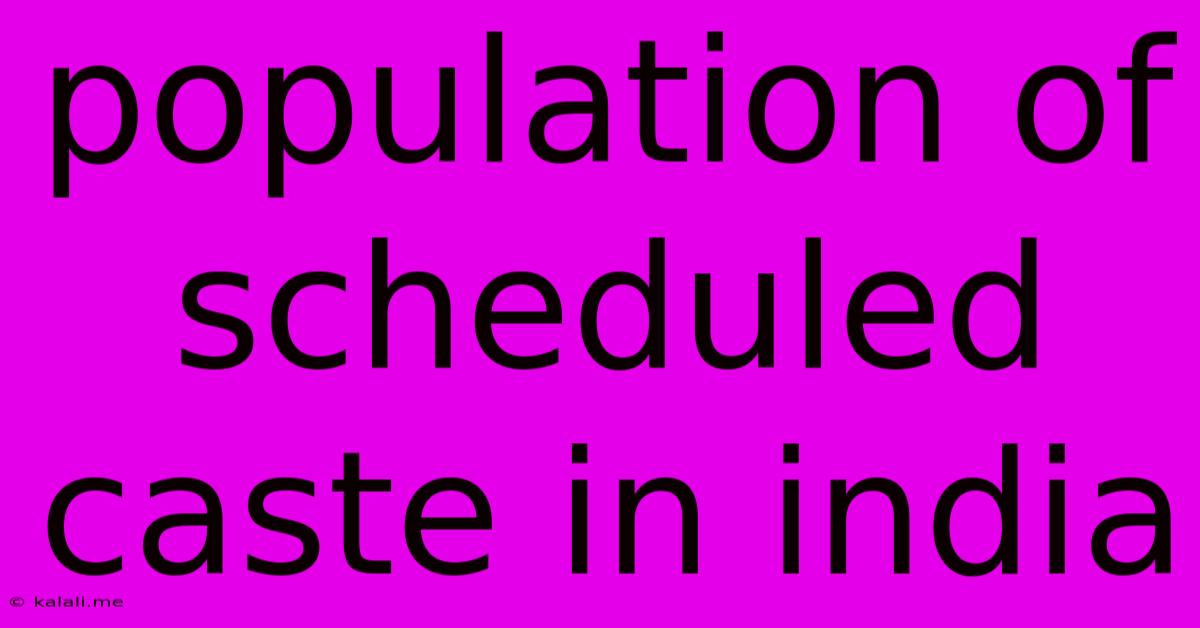Population Of Scheduled Caste In India
Kalali
Jun 15, 2025 · 4 min read

Table of Contents
The Population of Scheduled Castes in India: A Complex Demographic Landscape
Meta Description: Explore the history, current demographics, and socio-economic realities of the Scheduled Castes (Dalits) in India, a significant population group facing ongoing challenges and striving for equality. This article delves into their representation, challenges, and ongoing efforts towards social justice.
India's social fabric is intricately woven with diverse communities, and understanding its demographic landscape is crucial. A significant part of this landscape is comprised of the Scheduled Castes (SCs), also known as Dalits, a population group historically marginalized and facing systemic discrimination. This article explores the current population of Scheduled Castes in India, their socio-economic conditions, and the ongoing efforts to address historical injustices and promote social inclusion.
Historical Context of Scheduled Castes in India
The term "Scheduled Castes" originated from the Indian Constitution, listing communities historically subjected to social discrimination and oppression under the caste system. This system, deeply rooted in Indian society, created a rigid social hierarchy, relegating certain groups to the lowest rungs with limited access to resources, education, and opportunities. The Constitution’s provisions aimed to uplift these marginalized groups by providing them with affirmative action and protection against discrimination.
Current Population Estimates and Distribution
Precise figures for the Scheduled Caste population fluctuate slightly depending on the census year and methodology. However, they consistently represent a substantial portion of India's total population. While exact numbers vary slightly between censuses, the SC population constitutes a significant percentage of the overall Indian population. Their distribution is not uniform across India; some states have a considerably higher concentration of SC individuals than others. Understanding this uneven distribution is vital for targeted policy interventions aimed at improving their living conditions and opportunities.
Socio-Economic Conditions and Challenges
Despite constitutional safeguards and affirmative action policies, the Scheduled Castes continue to face significant socio-economic challenges. These include:
- Poverty and Unemployment: Many SC individuals remain trapped in a cycle of poverty, with limited access to quality education and employment opportunities. This often leads to intergenerational poverty and limited social mobility.
- Limited Access to Education and Healthcare: Inequalities in access to quality education and healthcare persist, further exacerbating existing disparities and hindering social progress. This lack of access creates a significant barrier to upward mobility.
- Caste-Based Discrimination and Violence: Despite legal protections, caste-based discrimination and violence remain persistent issues, impacting the lives and well-being of SC individuals. This insidious form of discrimination manifests in various ways, from social exclusion to physical violence.
- Land Ownership and Access to Resources: Historically disadvantaged access to land and other crucial resources continues to limit economic opportunities for many within the SC community. This lack of access perpetuates economic vulnerability.
Government Initiatives and Social Justice Efforts
The Indian government has implemented numerous initiatives to address the challenges faced by the Scheduled Castes. These initiatives include:
- Reservation Policies: Reservations in education and government jobs are designed to provide SC individuals with greater opportunities. These policies aim to create a more equitable representation in various sectors.
- Social Welfare Schemes: Various social welfare schemes provide financial assistance and support services to SC communities. These schemes are crucial for improving their living conditions and well-being.
- Legal Framework: The legal framework protects SC individuals from discrimination and violence. However, enforcement remains a key challenge.
- Empowerment Programs: Initiatives focusing on empowerment and skill development aim to equip SC individuals with the tools they need to participate fully in the economy and society. These programs aim to break the cycle of poverty and discrimination.
Conclusion: The Path Towards Equality
The population of Scheduled Castes in India represents a significant and vital part of the nation's social fabric. While substantial progress has been made, the challenges faced by this community remain considerable. Continued commitment to affirmative action, effective enforcement of anti-discrimination laws, and sustained efforts to address underlying social inequalities are essential for achieving true social justice and ensuring the full participation of Scheduled Castes in India's progress and prosperity. Further research and data analysis are crucial to monitor the effectiveness of existing policies and to inform the development of more targeted and impactful interventions. Only through sustained effort and inclusive policies can India truly overcome the legacy of caste-based discrimination and build a more equitable society for all its citizens.
Latest Posts
Latest Posts
-
The Bat Is The Only Mammal That Can Fly
Jun 15, 2025
-
A Process By Which Two Pieces Of Metal Are Joined
Jun 15, 2025
-
Which Of The Following Does Not Contribute To Water Pollution
Jun 15, 2025
-
Which Of The Following Equations Is Correct
Jun 15, 2025
-
A Group Of Similar Cells Performing A Specific Function
Jun 15, 2025
Related Post
Thank you for visiting our website which covers about Population Of Scheduled Caste In India . We hope the information provided has been useful to you. Feel free to contact us if you have any questions or need further assistance. See you next time and don't miss to bookmark.